A Critical Analysis of Asthma Patient Care in an Emergency Department
VerifiedAdded on 2020/01/07
|13
|4684
|231
Report
AI Summary
This report presents a critical analysis of an asthma patient, Joan Bloggs, who experienced a severe asthma attack in an emergency department. The analysis covers the patient's symptoms, medical history, and the care provided, including oxygen therapy, nebulizers, and oral steroids. It explores crisis resource management (CRM) principles and the impact of various care models. The report details the primary and secondary surveys conducted, pathology results, and social and psychological factors influencing the patient's condition. It also discusses the nursing and medical interventions implemented, such as the use of Hudson masks for oxygen delivery, medication administration, and the development of patient management strategies. The report emphasizes the importance of continuous monitoring, inhaler technique, and adherence to therapy in asthma management, highlighting the need for a comprehensive approach to patient care in emergency situations. It also mentions various interventions and management strategies implemented for the effective treatment of the patient. The report also discusses the importance of various interventions and management strategies for the effective treatment of the patient, which includes the identification of the patient, self-assessment of the patient, and chart reminders.
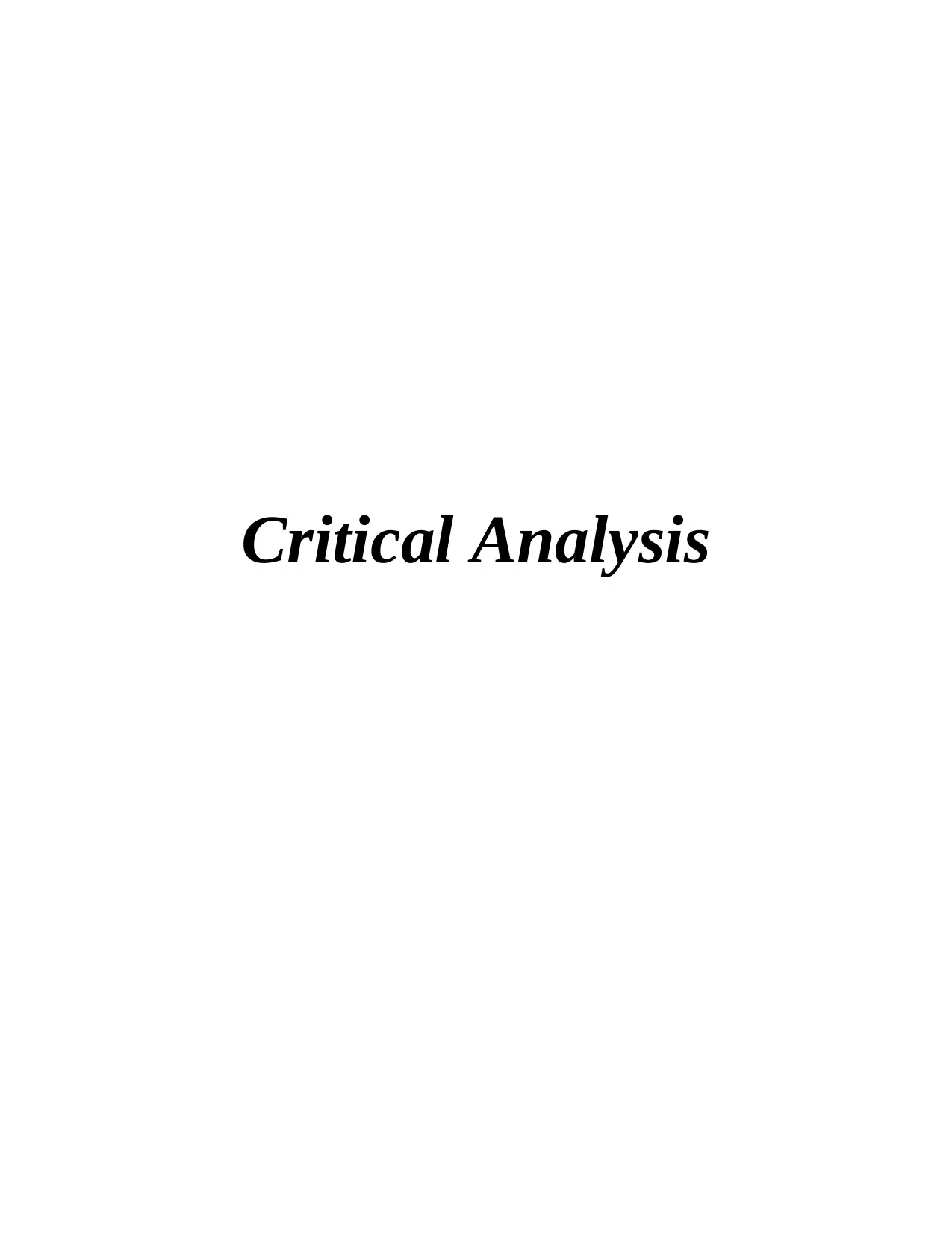
Critical Analysis
Paraphrase This Document
Need a fresh take? Get an instant paraphrase of this document with our AI Paraphraser
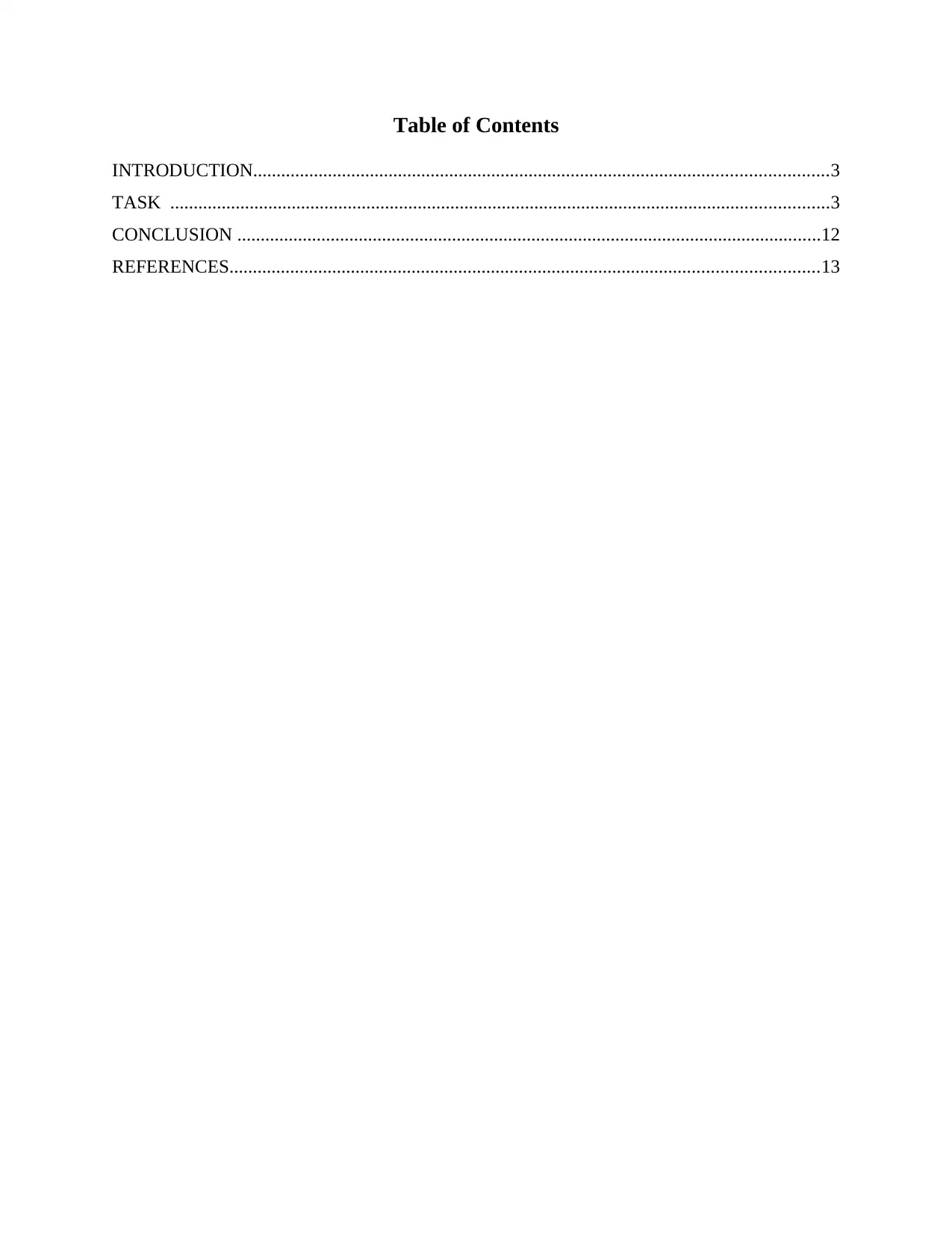
Table of Contents
INTRODUCTION...........................................................................................................................3
TASK .............................................................................................................................................3
CONCLUSION .............................................................................................................................12
REFERENCES..............................................................................................................................13
INTRODUCTION...........................................................................................................................3
TASK .............................................................................................................................................3
CONCLUSION .............................................................................................................................12
REFERENCES..............................................................................................................................13
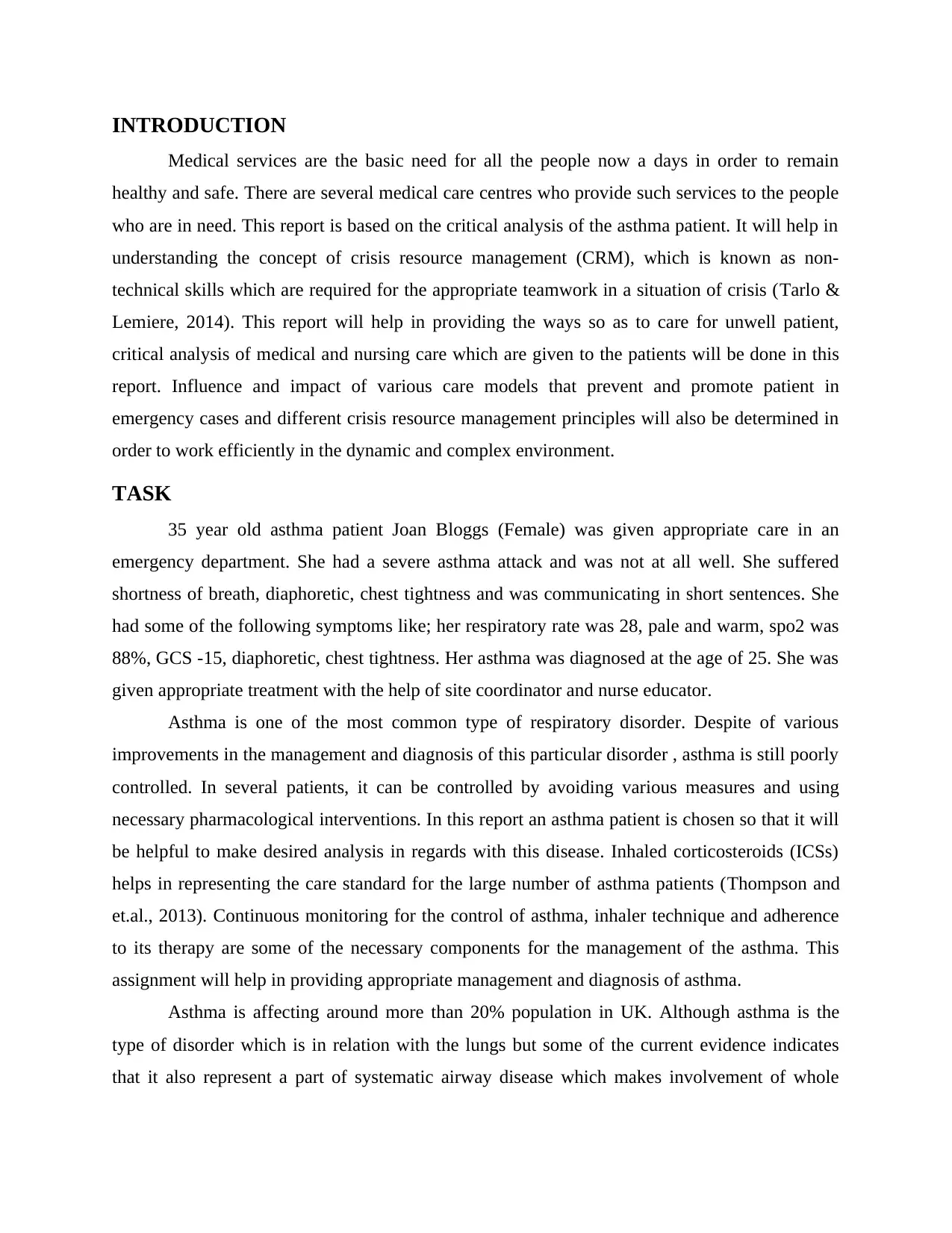
INTRODUCTION
Medical services are the basic need for all the people now a days in order to remain
healthy and safe. There are several medical care centres who provide such services to the people
who are in need. This report is based on the critical analysis of the asthma patient. It will help in
understanding the concept of crisis resource management (CRM), which is known as non-
technical skills which are required for the appropriate teamwork in a situation of crisis (Tarlo &
Lemiere, 2014). This report will help in providing the ways so as to care for unwell patient,
critical analysis of medical and nursing care which are given to the patients will be done in this
report. Influence and impact of various care models that prevent and promote patient in
emergency cases and different crisis resource management principles will also be determined in
order to work efficiently in the dynamic and complex environment.
TASK
35 year old asthma patient Joan Bloggs (Female) was given appropriate care in an
emergency department. She had a severe asthma attack and was not at all well. She suffered
shortness of breath, diaphoretic, chest tightness and was communicating in short sentences. She
had some of the following symptoms like; her respiratory rate was 28, pale and warm, spo2 was
88%, GCS -15, diaphoretic, chest tightness. Her asthma was diagnosed at the age of 25. She was
given appropriate treatment with the help of site coordinator and nurse educator.
Asthma is one of the most common type of respiratory disorder. Despite of various
improvements in the management and diagnosis of this particular disorder , asthma is still poorly
controlled. In several patients, it can be controlled by avoiding various measures and using
necessary pharmacological interventions. In this report an asthma patient is chosen so that it will
be helpful to make desired analysis in regards with this disease. Inhaled corticosteroids (ICSs)
helps in representing the care standard for the large number of asthma patients (Thompson and
et.al., 2013). Continuous monitoring for the control of asthma, inhaler technique and adherence
to its therapy are some of the necessary components for the management of the asthma. This
assignment will help in providing appropriate management and diagnosis of asthma.
Asthma is affecting around more than 20% population in UK. Although asthma is the
type of disorder which is in relation with the lungs but some of the current evidence indicates
that it also represent a part of systematic airway disease which makes involvement of whole
Medical services are the basic need for all the people now a days in order to remain
healthy and safe. There are several medical care centres who provide such services to the people
who are in need. This report is based on the critical analysis of the asthma patient. It will help in
understanding the concept of crisis resource management (CRM), which is known as non-
technical skills which are required for the appropriate teamwork in a situation of crisis (Tarlo &
Lemiere, 2014). This report will help in providing the ways so as to care for unwell patient,
critical analysis of medical and nursing care which are given to the patients will be done in this
report. Influence and impact of various care models that prevent and promote patient in
emergency cases and different crisis resource management principles will also be determined in
order to work efficiently in the dynamic and complex environment.
TASK
35 year old asthma patient Joan Bloggs (Female) was given appropriate care in an
emergency department. She had a severe asthma attack and was not at all well. She suffered
shortness of breath, diaphoretic, chest tightness and was communicating in short sentences. She
had some of the following symptoms like; her respiratory rate was 28, pale and warm, spo2 was
88%, GCS -15, diaphoretic, chest tightness. Her asthma was diagnosed at the age of 25. She was
given appropriate treatment with the help of site coordinator and nurse educator.
Asthma is one of the most common type of respiratory disorder. Despite of various
improvements in the management and diagnosis of this particular disorder , asthma is still poorly
controlled. In several patients, it can be controlled by avoiding various measures and using
necessary pharmacological interventions. In this report an asthma patient is chosen so that it will
be helpful to make desired analysis in regards with this disease. Inhaled corticosteroids (ICSs)
helps in representing the care standard for the large number of asthma patients (Thompson and
et.al., 2013). Continuous monitoring for the control of asthma, inhaler technique and adherence
to its therapy are some of the necessary components for the management of the asthma. This
assignment will help in providing appropriate management and diagnosis of asthma.
Asthma is affecting around more than 20% population in UK. Although asthma is the
type of disorder which is in relation with the lungs but some of the current evidence indicates
that it also represent a part of systematic airway disease which makes involvement of whole
⊘ This is a preview!⊘
Do you want full access?
Subscribe today to unlock all pages.

Trusted by 1+ million students worldwide
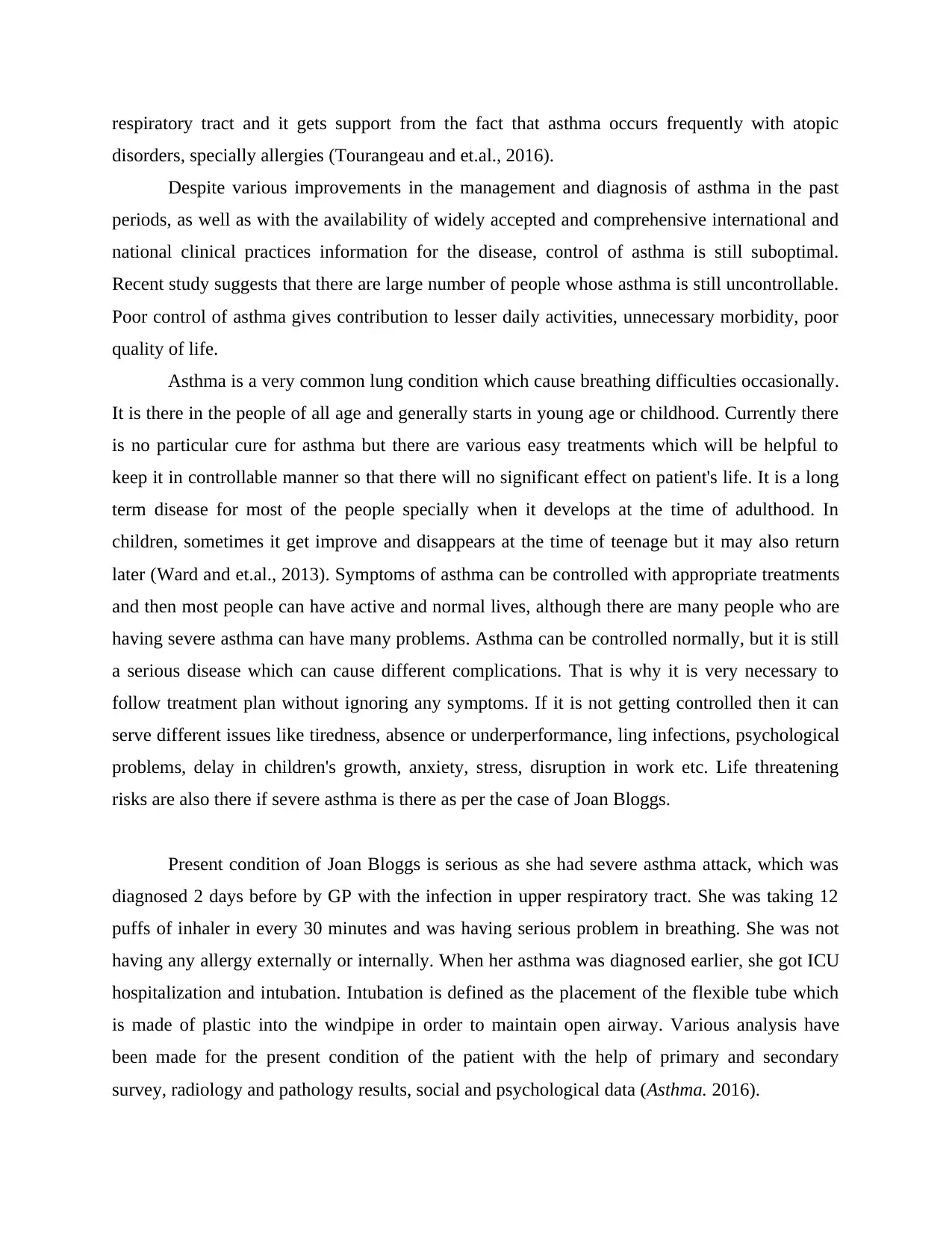
respiratory tract and it gets support from the fact that asthma occurs frequently with atopic
disorders, specially allergies (Tourangeau and et.al., 2016).
Despite various improvements in the management and diagnosis of asthma in the past
periods, as well as with the availability of widely accepted and comprehensive international and
national clinical practices information for the disease, control of asthma is still suboptimal.
Recent study suggests that there are large number of people whose asthma is still uncontrollable.
Poor control of asthma gives contribution to lesser daily activities, unnecessary morbidity, poor
quality of life.
Asthma is a very common lung condition which cause breathing difficulties occasionally.
It is there in the people of all age and generally starts in young age or childhood. Currently there
is no particular cure for asthma but there are various easy treatments which will be helpful to
keep it in controllable manner so that there will no significant effect on patient's life. It is a long
term disease for most of the people specially when it develops at the time of adulthood. In
children, sometimes it get improve and disappears at the time of teenage but it may also return
later (Ward and et.al., 2013). Symptoms of asthma can be controlled with appropriate treatments
and then most people can have active and normal lives, although there are many people who are
having severe asthma can have many problems. Asthma can be controlled normally, but it is still
a serious disease which can cause different complications. That is why it is very necessary to
follow treatment plan without ignoring any symptoms. If it is not getting controlled then it can
serve different issues like tiredness, absence or underperformance, ling infections, psychological
problems, delay in children's growth, anxiety, stress, disruption in work etc. Life threatening
risks are also there if severe asthma is there as per the case of Joan Bloggs.
Present condition of Joan Bloggs is serious as she had severe asthma attack, which was
diagnosed 2 days before by GP with the infection in upper respiratory tract. She was taking 12
puffs of inhaler in every 30 minutes and was having serious problem in breathing. She was not
having any allergy externally or internally. When her asthma was diagnosed earlier, she got ICU
hospitalization and intubation. Intubation is defined as the placement of the flexible tube which
is made of plastic into the windpipe in order to maintain open airway. Various analysis have
been made for the present condition of the patient with the help of primary and secondary
survey, radiology and pathology results, social and psychological data (Asthma. 2016).
disorders, specially allergies (Tourangeau and et.al., 2016).
Despite various improvements in the management and diagnosis of asthma in the past
periods, as well as with the availability of widely accepted and comprehensive international and
national clinical practices information for the disease, control of asthma is still suboptimal.
Recent study suggests that there are large number of people whose asthma is still uncontrollable.
Poor control of asthma gives contribution to lesser daily activities, unnecessary morbidity, poor
quality of life.
Asthma is a very common lung condition which cause breathing difficulties occasionally.
It is there in the people of all age and generally starts in young age or childhood. Currently there
is no particular cure for asthma but there are various easy treatments which will be helpful to
keep it in controllable manner so that there will no significant effect on patient's life. It is a long
term disease for most of the people specially when it develops at the time of adulthood. In
children, sometimes it get improve and disappears at the time of teenage but it may also return
later (Ward and et.al., 2013). Symptoms of asthma can be controlled with appropriate treatments
and then most people can have active and normal lives, although there are many people who are
having severe asthma can have many problems. Asthma can be controlled normally, but it is still
a serious disease which can cause different complications. That is why it is very necessary to
follow treatment plan without ignoring any symptoms. If it is not getting controlled then it can
serve different issues like tiredness, absence or underperformance, ling infections, psychological
problems, delay in children's growth, anxiety, stress, disruption in work etc. Life threatening
risks are also there if severe asthma is there as per the case of Joan Bloggs.
Present condition of Joan Bloggs is serious as she had severe asthma attack, which was
diagnosed 2 days before by GP with the infection in upper respiratory tract. She was taking 12
puffs of inhaler in every 30 minutes and was having serious problem in breathing. She was not
having any allergy externally or internally. When her asthma was diagnosed earlier, she got ICU
hospitalization and intubation. Intubation is defined as the placement of the flexible tube which
is made of plastic into the windpipe in order to maintain open airway. Various analysis have
been made for the present condition of the patient with the help of primary and secondary
survey, radiology and pathology results, social and psychological data (Asthma. 2016).
Paraphrase This Document
Need a fresh take? Get an instant paraphrase of this document with our AI Paraphraser
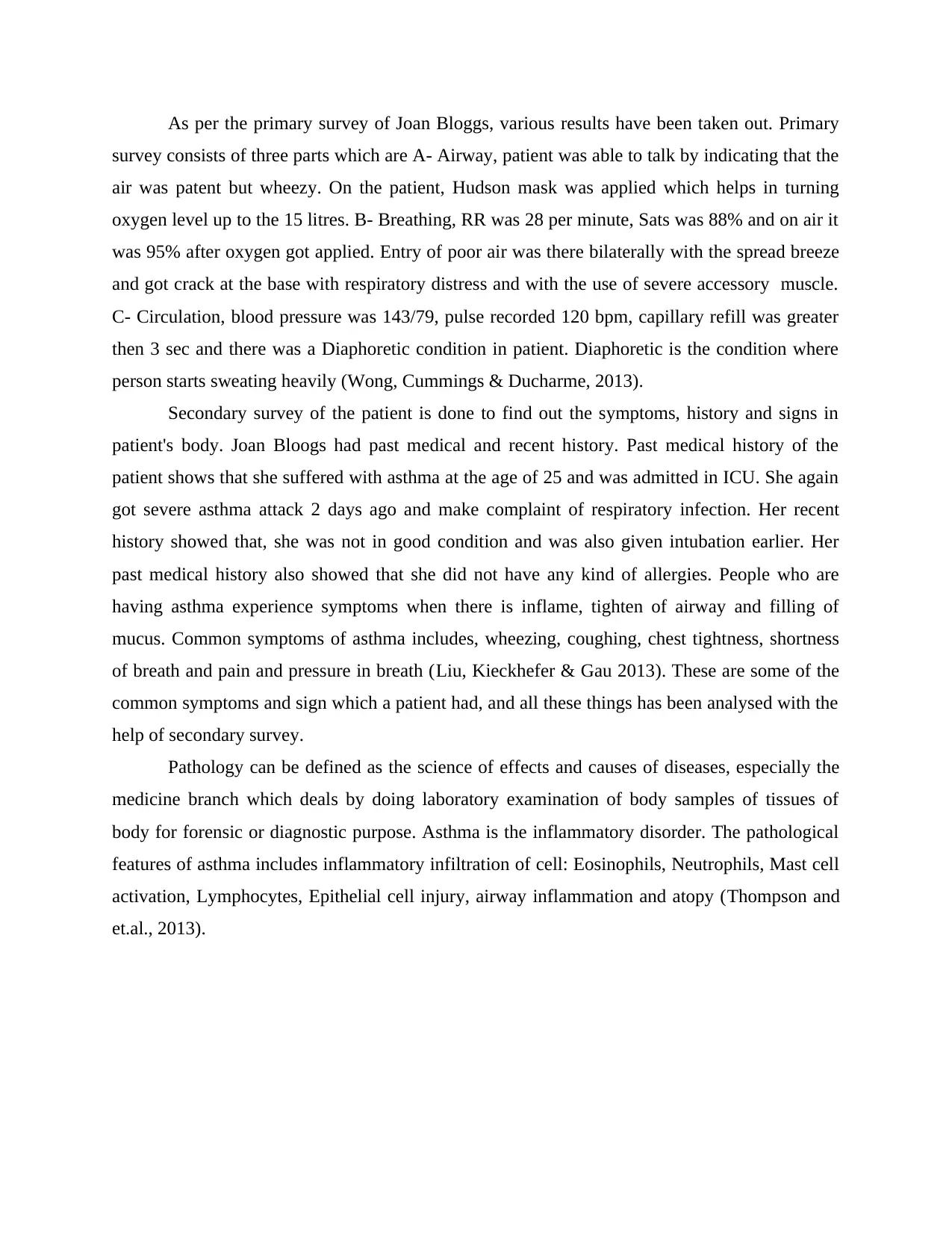
As per the primary survey of Joan Bloggs, various results have been taken out. Primary
survey consists of three parts which are A- Airway, patient was able to talk by indicating that the
air was patent but wheezy. On the patient, Hudson mask was applied which helps in turning
oxygen level up to the 15 litres. B- Breathing, RR was 28 per minute, Sats was 88% and on air it
was 95% after oxygen got applied. Entry of poor air was there bilaterally with the spread breeze
and got crack at the base with respiratory distress and with the use of severe accessory muscle.
C- Circulation, blood pressure was 143/79, pulse recorded 120 bpm, capillary refill was greater
then 3 sec and there was a Diaphoretic condition in patient. Diaphoretic is the condition where
person starts sweating heavily (Wong, Cummings & Ducharme, 2013).
Secondary survey of the patient is done to find out the symptoms, history and signs in
patient's body. Joan Bloogs had past medical and recent history. Past medical history of the
patient shows that she suffered with asthma at the age of 25 and was admitted in ICU. She again
got severe asthma attack 2 days ago and make complaint of respiratory infection. Her recent
history showed that, she was not in good condition and was also given intubation earlier. Her
past medical history also showed that she did not have any kind of allergies. People who are
having asthma experience symptoms when there is inflame, tighten of airway and filling of
mucus. Common symptoms of asthma includes, wheezing, coughing, chest tightness, shortness
of breath and pain and pressure in breath (Liu, Kieckhefer & Gau 2013). These are some of the
common symptoms and sign which a patient had, and all these things has been analysed with the
help of secondary survey.
Pathology can be defined as the science of effects and causes of diseases, especially the
medicine branch which deals by doing laboratory examination of body samples of tissues of
body for forensic or diagnostic purpose. Asthma is the inflammatory disorder. The pathological
features of asthma includes inflammatory infiltration of cell: Eosinophils, Neutrophils, Mast cell
activation, Lymphocytes, Epithelial cell injury, airway inflammation and atopy (Thompson and
et.al., 2013).
survey consists of three parts which are A- Airway, patient was able to talk by indicating that the
air was patent but wheezy. On the patient, Hudson mask was applied which helps in turning
oxygen level up to the 15 litres. B- Breathing, RR was 28 per minute, Sats was 88% and on air it
was 95% after oxygen got applied. Entry of poor air was there bilaterally with the spread breeze
and got crack at the base with respiratory distress and with the use of severe accessory muscle.
C- Circulation, blood pressure was 143/79, pulse recorded 120 bpm, capillary refill was greater
then 3 sec and there was a Diaphoretic condition in patient. Diaphoretic is the condition where
person starts sweating heavily (Wong, Cummings & Ducharme, 2013).
Secondary survey of the patient is done to find out the symptoms, history and signs in
patient's body. Joan Bloogs had past medical and recent history. Past medical history of the
patient shows that she suffered with asthma at the age of 25 and was admitted in ICU. She again
got severe asthma attack 2 days ago and make complaint of respiratory infection. Her recent
history showed that, she was not in good condition and was also given intubation earlier. Her
past medical history also showed that she did not have any kind of allergies. People who are
having asthma experience symptoms when there is inflame, tighten of airway and filling of
mucus. Common symptoms of asthma includes, wheezing, coughing, chest tightness, shortness
of breath and pain and pressure in breath (Liu, Kieckhefer & Gau 2013). These are some of the
common symptoms and sign which a patient had, and all these things has been analysed with the
help of secondary survey.
Pathology can be defined as the science of effects and causes of diseases, especially the
medicine branch which deals by doing laboratory examination of body samples of tissues of
body for forensic or diagnostic purpose. Asthma is the inflammatory disorder. The pathological
features of asthma includes inflammatory infiltration of cell: Eosinophils, Neutrophils, Mast cell
activation, Lymphocytes, Epithelial cell injury, airway inflammation and atopy (Thompson and
et.al., 2013).
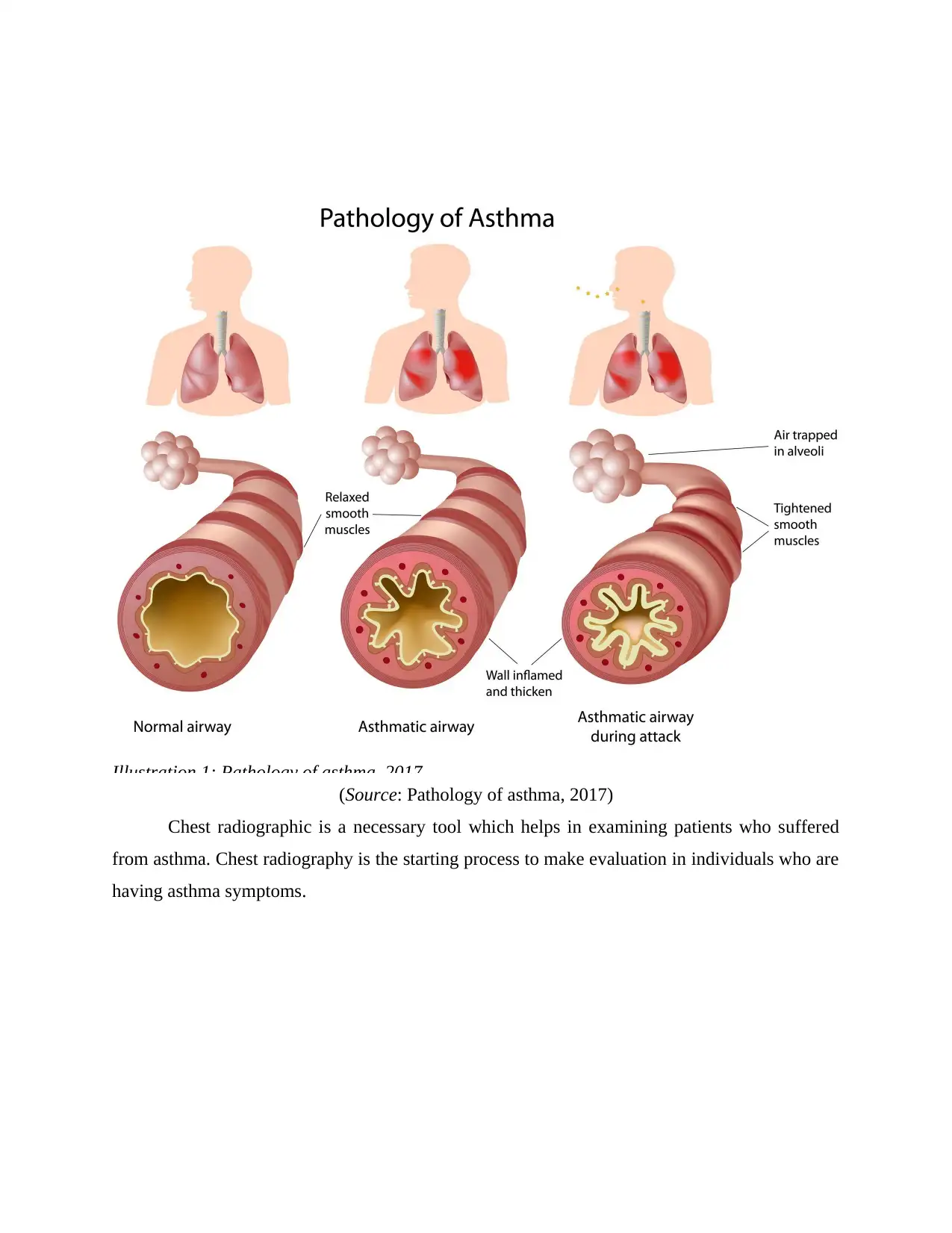
(Source: Pathology of asthma, 2017)
Chest radiographic is a necessary tool which helps in examining patients who suffered
from asthma. Chest radiography is the starting process to make evaluation in individuals who are
having asthma symptoms.
Illustration 1: Pathology of asthma, 2017
Chest radiographic is a necessary tool which helps in examining patients who suffered
from asthma. Chest radiography is the starting process to make evaluation in individuals who are
having asthma symptoms.
Illustration 1: Pathology of asthma, 2017
⊘ This is a preview!⊘
Do you want full access?
Subscribe today to unlock all pages.

Trusted by 1+ million students worldwide
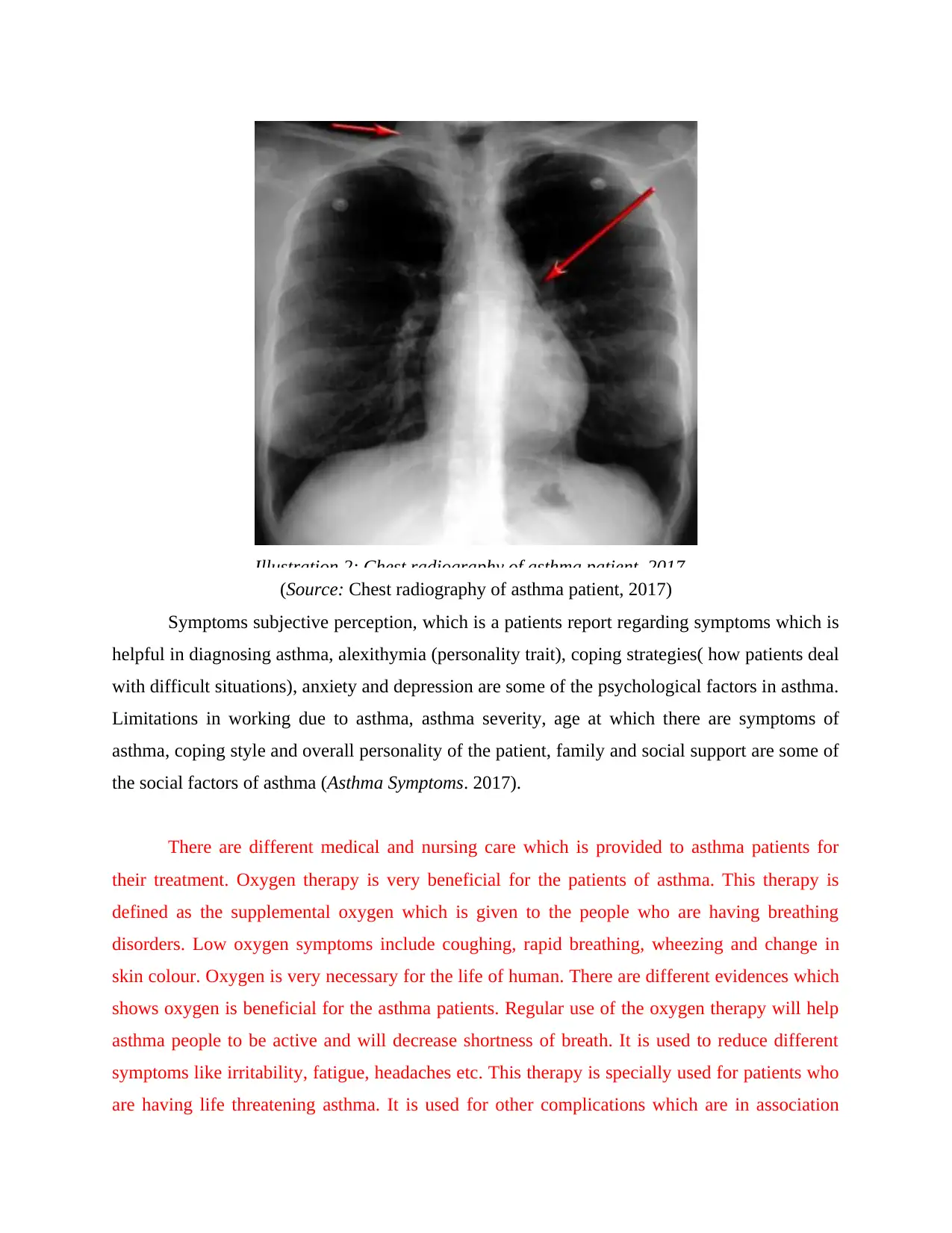
(Source: Chest radiography of asthma patient, 2017)
Symptoms subjective perception, which is a patients report regarding symptoms which is
helpful in diagnosing asthma, alexithymia (personality trait), coping strategies( how patients deal
with difficult situations), anxiety and depression are some of the psychological factors in asthma.
Limitations in working due to asthma, asthma severity, age at which there are symptoms of
asthma, coping style and overall personality of the patient, family and social support are some of
the social factors of asthma (Asthma Symptoms. 2017).
There are different medical and nursing care which is provided to asthma patients for
their treatment. Oxygen therapy is very beneficial for the patients of asthma. This therapy is
defined as the supplemental oxygen which is given to the people who are having breathing
disorders. Low oxygen symptoms include coughing, rapid breathing, wheezing and change in
skin colour. Oxygen is very necessary for the life of human. There are different evidences which
shows oxygen is beneficial for the asthma patients. Regular use of the oxygen therapy will help
asthma people to be active and will decrease shortness of breath. It is used to reduce different
symptoms like irritability, fatigue, headaches etc. This therapy is specially used for patients who
are having life threatening asthma. It is used for other complications which are in association
Illustration 2: Chest radiography of asthma patient, 2017
Symptoms subjective perception, which is a patients report regarding symptoms which is
helpful in diagnosing asthma, alexithymia (personality trait), coping strategies( how patients deal
with difficult situations), anxiety and depression are some of the psychological factors in asthma.
Limitations in working due to asthma, asthma severity, age at which there are symptoms of
asthma, coping style and overall personality of the patient, family and social support are some of
the social factors of asthma (Asthma Symptoms. 2017).
There are different medical and nursing care which is provided to asthma patients for
their treatment. Oxygen therapy is very beneficial for the patients of asthma. This therapy is
defined as the supplemental oxygen which is given to the people who are having breathing
disorders. Low oxygen symptoms include coughing, rapid breathing, wheezing and change in
skin colour. Oxygen is very necessary for the life of human. There are different evidences which
shows oxygen is beneficial for the asthma patients. Regular use of the oxygen therapy will help
asthma people to be active and will decrease shortness of breath. It is used to reduce different
symptoms like irritability, fatigue, headaches etc. This therapy is specially used for patients who
are having life threatening asthma. It is used for other complications which are in association
Illustration 2: Chest radiography of asthma patient, 2017
Paraphrase This Document
Need a fresh take? Get an instant paraphrase of this document with our AI Paraphraser
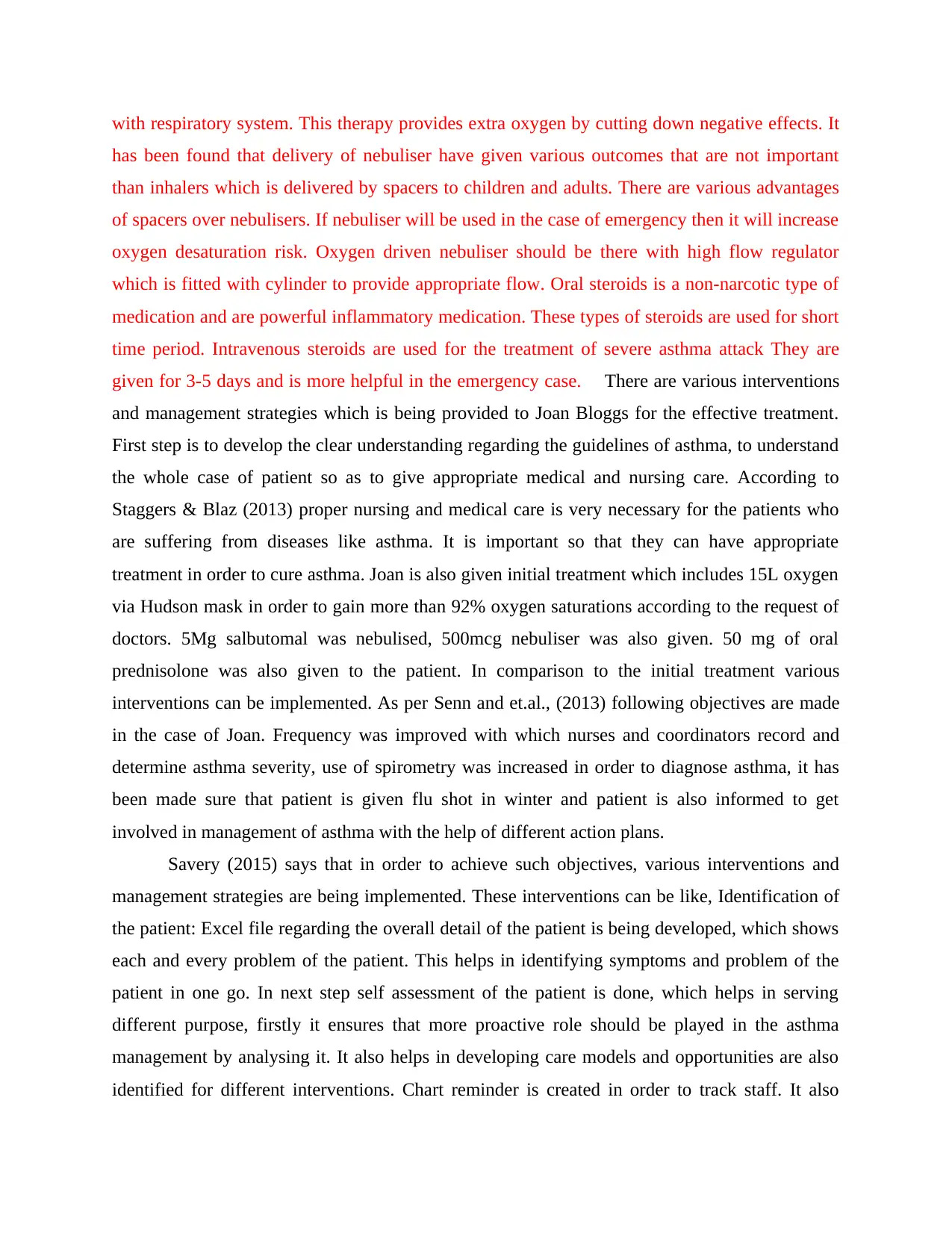
with respiratory system. This therapy provides extra oxygen by cutting down negative effects. It
has been found that delivery of nebuliser have given various outcomes that are not important
than inhalers which is delivered by spacers to children and adults. There are various advantages
of spacers over nebulisers. If nebuliser will be used in the case of emergency then it will increase
oxygen desaturation risk. Oxygen driven nebuliser should be there with high flow regulator
which is fitted with cylinder to provide appropriate flow. Oral steroids is a non-narcotic type of
medication and are powerful inflammatory medication. These types of steroids are used for short
time period. Intravenous steroids are used for the treatment of severe asthma attack They are
given for 3-5 days and is more helpful in the emergency case. There are various interventions
and management strategies which is being provided to Joan Bloggs for the effective treatment.
First step is to develop the clear understanding regarding the guidelines of asthma, to understand
the whole case of patient so as to give appropriate medical and nursing care. According to
Staggers & Blaz (2013) proper nursing and medical care is very necessary for the patients who
are suffering from diseases like asthma. It is important so that they can have appropriate
treatment in order to cure asthma. Joan is also given initial treatment which includes 15L oxygen
via Hudson mask in order to gain more than 92% oxygen saturations according to the request of
doctors. 5Mg salbutomal was nebulised, 500mcg nebuliser was also given. 50 mg of oral
prednisolone was also given to the patient. In comparison to the initial treatment various
interventions can be implemented. As per Senn and et.al., (2013) following objectives are made
in the case of Joan. Frequency was improved with which nurses and coordinators record and
determine asthma severity, use of spirometry was increased in order to diagnose asthma, it has
been made sure that patient is given flu shot in winter and patient is also informed to get
involved in management of asthma with the help of different action plans.
Savery (2015) says that in order to achieve such objectives, various interventions and
management strategies are being implemented. These interventions can be like, Identification of
the patient: Excel file regarding the overall detail of the patient is being developed, which shows
each and every problem of the patient. This helps in identifying symptoms and problem of the
patient in one go. In next step self assessment of the patient is done, which helps in serving
different purpose, firstly it ensures that more proactive role should be played in the asthma
management by analysing it. It also helps in developing care models and opportunities are also
identified for different interventions. Chart reminder is created in order to track staff. It also
has been found that delivery of nebuliser have given various outcomes that are not important
than inhalers which is delivered by spacers to children and adults. There are various advantages
of spacers over nebulisers. If nebuliser will be used in the case of emergency then it will increase
oxygen desaturation risk. Oxygen driven nebuliser should be there with high flow regulator
which is fitted with cylinder to provide appropriate flow. Oral steroids is a non-narcotic type of
medication and are powerful inflammatory medication. These types of steroids are used for short
time period. Intravenous steroids are used for the treatment of severe asthma attack They are
given for 3-5 days and is more helpful in the emergency case. There are various interventions
and management strategies which is being provided to Joan Bloggs for the effective treatment.
First step is to develop the clear understanding regarding the guidelines of asthma, to understand
the whole case of patient so as to give appropriate medical and nursing care. According to
Staggers & Blaz (2013) proper nursing and medical care is very necessary for the patients who
are suffering from diseases like asthma. It is important so that they can have appropriate
treatment in order to cure asthma. Joan is also given initial treatment which includes 15L oxygen
via Hudson mask in order to gain more than 92% oxygen saturations according to the request of
doctors. 5Mg salbutomal was nebulised, 500mcg nebuliser was also given. 50 mg of oral
prednisolone was also given to the patient. In comparison to the initial treatment various
interventions can be implemented. As per Senn and et.al., (2013) following objectives are made
in the case of Joan. Frequency was improved with which nurses and coordinators record and
determine asthma severity, use of spirometry was increased in order to diagnose asthma, it has
been made sure that patient is given flu shot in winter and patient is also informed to get
involved in management of asthma with the help of different action plans.
Savery (2015) says that in order to achieve such objectives, various interventions and
management strategies are being implemented. These interventions can be like, Identification of
the patient: Excel file regarding the overall detail of the patient is being developed, which shows
each and every problem of the patient. This helps in identifying symptoms and problem of the
patient in one go. In next step self assessment of the patient is done, which helps in serving
different purpose, firstly it ensures that more proactive role should be played in the asthma
management by analysing it. It also helps in developing care models and opportunities are also
identified for different interventions. Chart reminder is created in order to track staff. It also
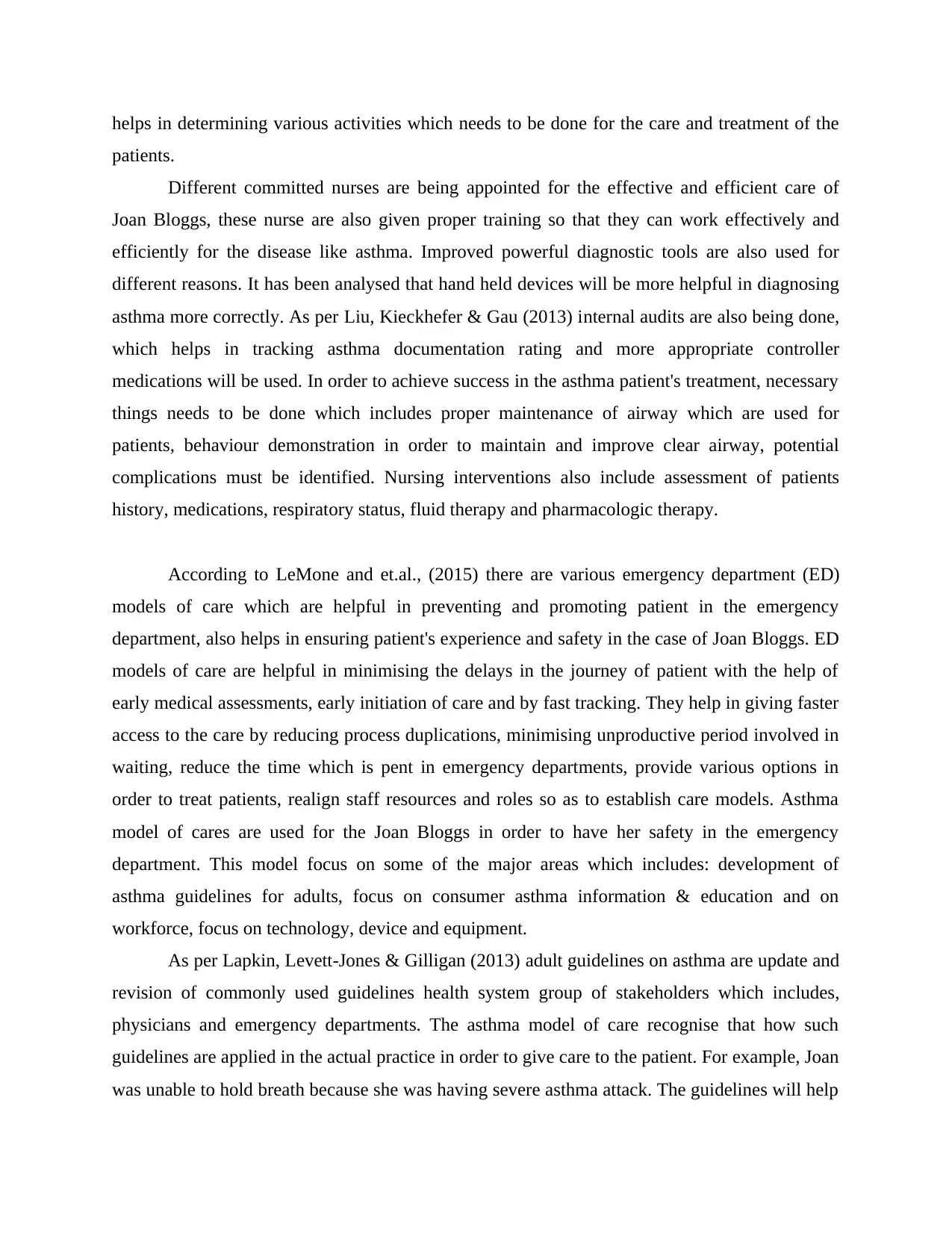
helps in determining various activities which needs to be done for the care and treatment of the
patients.
Different committed nurses are being appointed for the effective and efficient care of
Joan Bloggs, these nurse are also given proper training so that they can work effectively and
efficiently for the disease like asthma. Improved powerful diagnostic tools are also used for
different reasons. It has been analysed that hand held devices will be more helpful in diagnosing
asthma more correctly. As per Liu, Kieckhefer & Gau (2013) internal audits are also being done,
which helps in tracking asthma documentation rating and more appropriate controller
medications will be used. In order to achieve success in the asthma patient's treatment, necessary
things needs to be done which includes proper maintenance of airway which are used for
patients, behaviour demonstration in order to maintain and improve clear airway, potential
complications must be identified. Nursing interventions also include assessment of patients
history, medications, respiratory status, fluid therapy and pharmacologic therapy.
According to LeMone and et.al., (2015) there are various emergency department (ED)
models of care which are helpful in preventing and promoting patient in the emergency
department, also helps in ensuring patient's experience and safety in the case of Joan Bloggs. ED
models of care are helpful in minimising the delays in the journey of patient with the help of
early medical assessments, early initiation of care and by fast tracking. They help in giving faster
access to the care by reducing process duplications, minimising unproductive period involved in
waiting, reduce the time which is pent in emergency departments, provide various options in
order to treat patients, realign staff resources and roles so as to establish care models. Asthma
model of cares are used for the Joan Bloggs in order to have her safety in the emergency
department. This model focus on some of the major areas which includes: development of
asthma guidelines for adults, focus on consumer asthma information & education and on
workforce, focus on technology, device and equipment.
As per Lapkin, Levett-Jones & Gilligan (2013) adult guidelines on asthma are update and
revision of commonly used guidelines health system group of stakeholders which includes,
physicians and emergency departments. The asthma model of care recognise that how such
guidelines are applied in the actual practice in order to give care to the patient. For example, Joan
was unable to hold breath because she was having severe asthma attack. The guidelines will help
patients.
Different committed nurses are being appointed for the effective and efficient care of
Joan Bloggs, these nurse are also given proper training so that they can work effectively and
efficiently for the disease like asthma. Improved powerful diagnostic tools are also used for
different reasons. It has been analysed that hand held devices will be more helpful in diagnosing
asthma more correctly. As per Liu, Kieckhefer & Gau (2013) internal audits are also being done,
which helps in tracking asthma documentation rating and more appropriate controller
medications will be used. In order to achieve success in the asthma patient's treatment, necessary
things needs to be done which includes proper maintenance of airway which are used for
patients, behaviour demonstration in order to maintain and improve clear airway, potential
complications must be identified. Nursing interventions also include assessment of patients
history, medications, respiratory status, fluid therapy and pharmacologic therapy.
According to LeMone and et.al., (2015) there are various emergency department (ED)
models of care which are helpful in preventing and promoting patient in the emergency
department, also helps in ensuring patient's experience and safety in the case of Joan Bloggs. ED
models of care are helpful in minimising the delays in the journey of patient with the help of
early medical assessments, early initiation of care and by fast tracking. They help in giving faster
access to the care by reducing process duplications, minimising unproductive period involved in
waiting, reduce the time which is pent in emergency departments, provide various options in
order to treat patients, realign staff resources and roles so as to establish care models. Asthma
model of cares are used for the Joan Bloggs in order to have her safety in the emergency
department. This model focus on some of the major areas which includes: development of
asthma guidelines for adults, focus on consumer asthma information & education and on
workforce, focus on technology, device and equipment.
As per Lapkin, Levett-Jones & Gilligan (2013) adult guidelines on asthma are update and
revision of commonly used guidelines health system group of stakeholders which includes,
physicians and emergency departments. The asthma model of care recognise that how such
guidelines are applied in the actual practice in order to give care to the patient. For example, Joan
was unable to hold breath because she was having severe asthma attack. The guidelines will help
⊘ This is a preview!⊘
Do you want full access?
Subscribe today to unlock all pages.

Trusted by 1+ million students worldwide
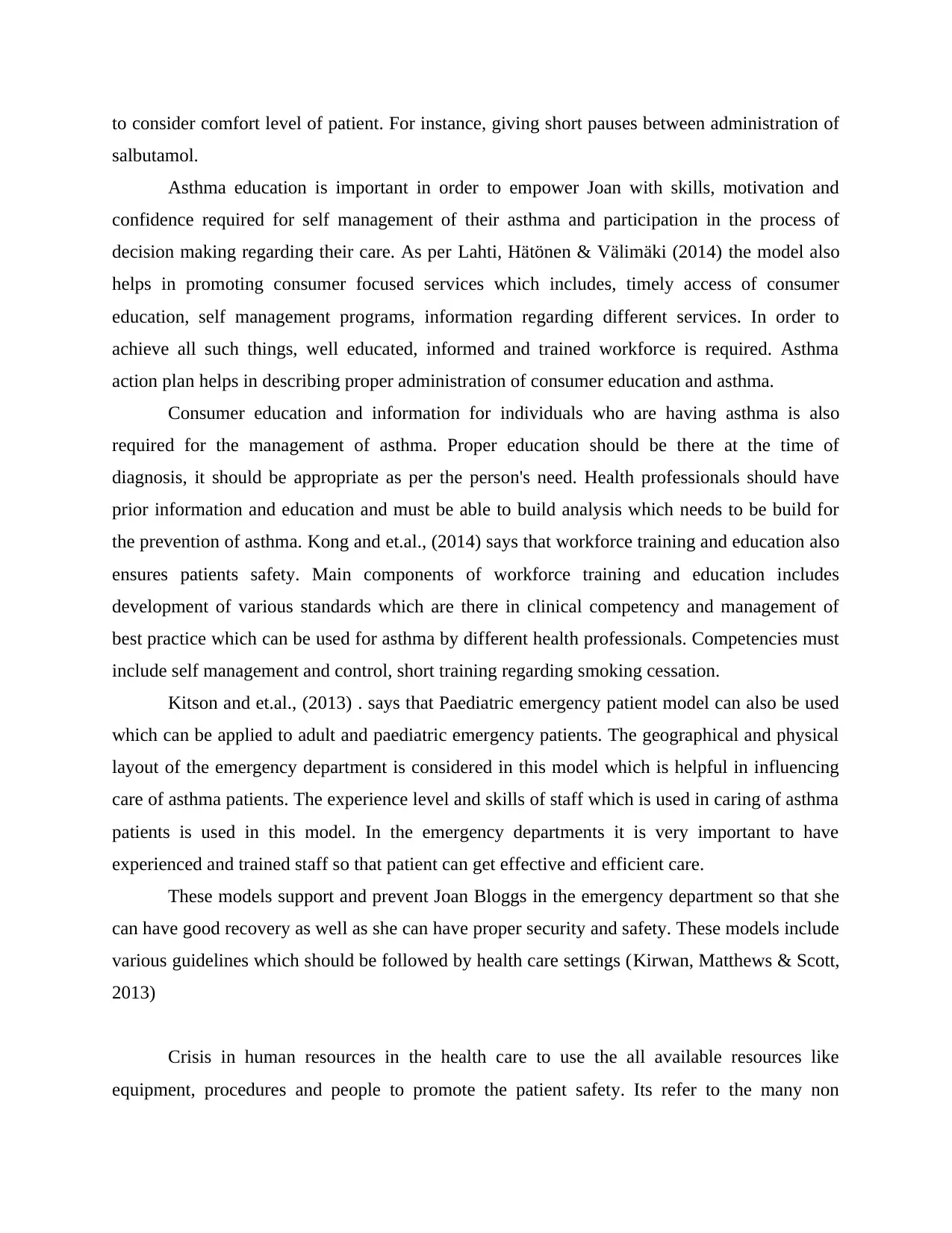
to consider comfort level of patient. For instance, giving short pauses between administration of
salbutamol.
Asthma education is important in order to empower Joan with skills, motivation and
confidence required for self management of their asthma and participation in the process of
decision making regarding their care. As per Lahti, Hätönen & Välimäki (2014) the model also
helps in promoting consumer focused services which includes, timely access of consumer
education, self management programs, information regarding different services. In order to
achieve all such things, well educated, informed and trained workforce is required. Asthma
action plan helps in describing proper administration of consumer education and asthma.
Consumer education and information for individuals who are having asthma is also
required for the management of asthma. Proper education should be there at the time of
diagnosis, it should be appropriate as per the person's need. Health professionals should have
prior information and education and must be able to build analysis which needs to be build for
the prevention of asthma. Kong and et.al., (2014) says that workforce training and education also
ensures patients safety. Main components of workforce training and education includes
development of various standards which are there in clinical competency and management of
best practice which can be used for asthma by different health professionals. Competencies must
include self management and control, short training regarding smoking cessation.
Kitson and et.al., (2013) . says that Paediatric emergency patient model can also be used
which can be applied to adult and paediatric emergency patients. The geographical and physical
layout of the emergency department is considered in this model which is helpful in influencing
care of asthma patients. The experience level and skills of staff which is used in caring of asthma
patients is used in this model. In the emergency departments it is very important to have
experienced and trained staff so that patient can get effective and efficient care.
These models support and prevent Joan Bloggs in the emergency department so that she
can have good recovery as well as she can have proper security and safety. These models include
various guidelines which should be followed by health care settings (Kirwan, Matthews & Scott,
2013)
Crisis in human resources in the health care to use the all available resources like
equipment, procedures and people to promote the patient safety. Its refer to the many non
salbutamol.
Asthma education is important in order to empower Joan with skills, motivation and
confidence required for self management of their asthma and participation in the process of
decision making regarding their care. As per Lahti, Hätönen & Välimäki (2014) the model also
helps in promoting consumer focused services which includes, timely access of consumer
education, self management programs, information regarding different services. In order to
achieve all such things, well educated, informed and trained workforce is required. Asthma
action plan helps in describing proper administration of consumer education and asthma.
Consumer education and information for individuals who are having asthma is also
required for the management of asthma. Proper education should be there at the time of
diagnosis, it should be appropriate as per the person's need. Health professionals should have
prior information and education and must be able to build analysis which needs to be build for
the prevention of asthma. Kong and et.al., (2014) says that workforce training and education also
ensures patients safety. Main components of workforce training and education includes
development of various standards which are there in clinical competency and management of
best practice which can be used for asthma by different health professionals. Competencies must
include self management and control, short training regarding smoking cessation.
Kitson and et.al., (2013) . says that Paediatric emergency patient model can also be used
which can be applied to adult and paediatric emergency patients. The geographical and physical
layout of the emergency department is considered in this model which is helpful in influencing
care of asthma patients. The experience level and skills of staff which is used in caring of asthma
patients is used in this model. In the emergency departments it is very important to have
experienced and trained staff so that patient can get effective and efficient care.
These models support and prevent Joan Bloggs in the emergency department so that she
can have good recovery as well as she can have proper security and safety. These models include
various guidelines which should be followed by health care settings (Kirwan, Matthews & Scott,
2013)
Crisis in human resources in the health care to use the all available resources like
equipment, procedures and people to promote the patient safety. Its refer to the many non
Paraphrase This Document
Need a fresh take? Get an instant paraphrase of this document with our AI Paraphraser
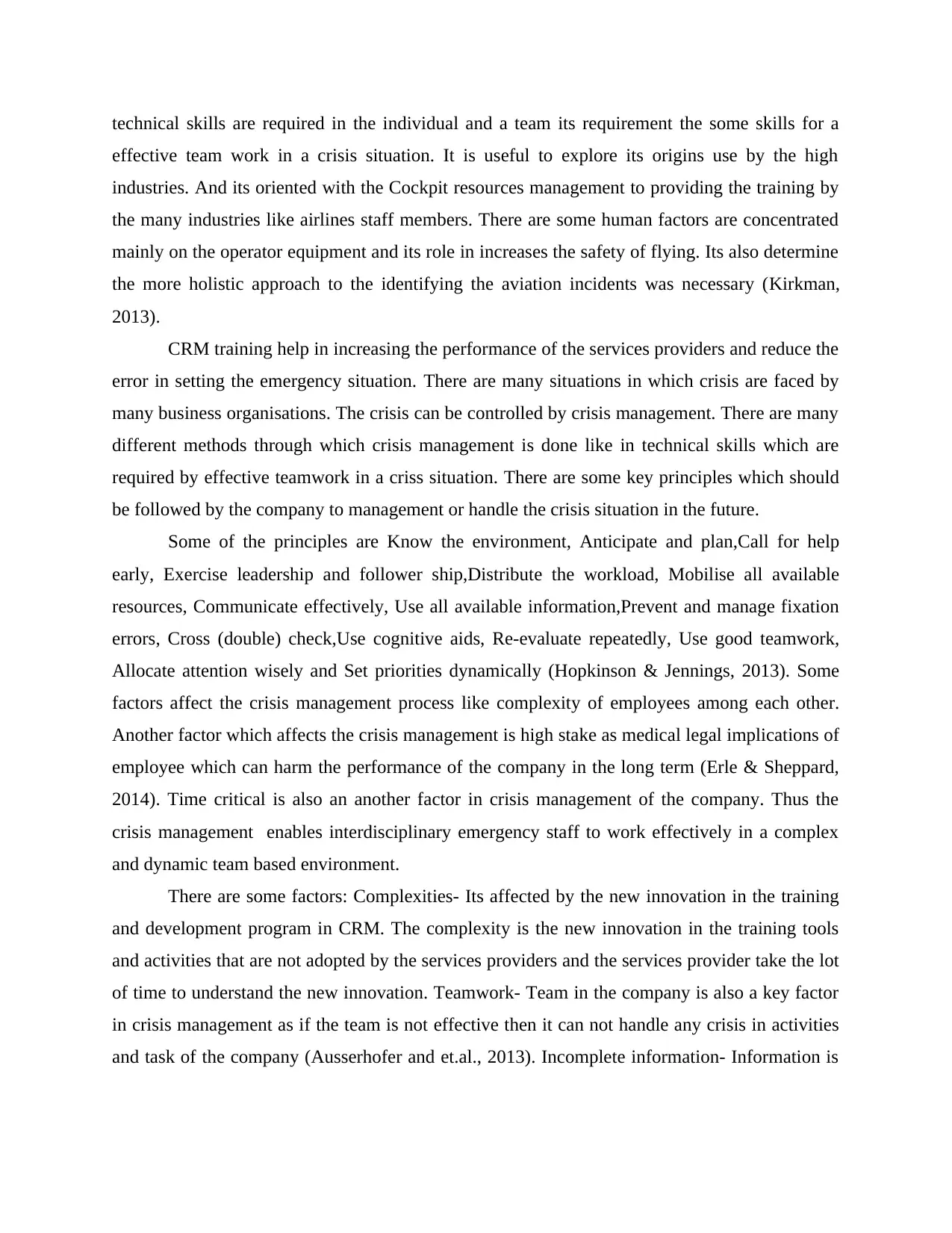
technical skills are required in the individual and a team its requirement the some skills for a
effective team work in a crisis situation. It is useful to explore its origins use by the high
industries. And its oriented with the Cockpit resources management to providing the training by
the many industries like airlines staff members. There are some human factors are concentrated
mainly on the operator equipment and its role in increases the safety of flying. Its also determine
the more holistic approach to the identifying the aviation incidents was necessary (Kirkman,
2013).
CRM training help in increasing the performance of the services providers and reduce the
error in setting the emergency situation. There are many situations in which crisis are faced by
many business organisations. The crisis can be controlled by crisis management. There are many
different methods through which crisis management is done like in technical skills which are
required by effective teamwork in a criss situation. There are some key principles which should
be followed by the company to management or handle the crisis situation in the future.
Some of the principles are Know the environment, Anticipate and plan,Call for help
early, Exercise leadership and follower ship,Distribute the workload, Mobilise all available
resources, Communicate effectively, Use all available information,Prevent and manage fixation
errors, Cross (double) check,Use cognitive aids, Re-evaluate repeatedly, Use good teamwork,
Allocate attention wisely and Set priorities dynamically (Hopkinson & Jennings, 2013). Some
factors affect the crisis management process like complexity of employees among each other.
Another factor which affects the crisis management is high stake as medical legal implications of
employee which can harm the performance of the company in the long term (Erle & Sheppard,
2014). Time critical is also an another factor in crisis management of the company. Thus the
crisis management enables interdisciplinary emergency staff to work effectively in a complex
and dynamic team based environment.
There are some factors: Complexities- Its affected by the new innovation in the training
and development program in CRM. The complexity is the new innovation in the training tools
and activities that are not adopted by the services providers and the services provider take the lot
of time to understand the new innovation. Teamwork- Team in the company is also a key factor
in crisis management as if the team is not effective then it can not handle any crisis in activities
and task of the company (Ausserhofer and et.al., 2013). Incomplete information- Information is
effective team work in a crisis situation. It is useful to explore its origins use by the high
industries. And its oriented with the Cockpit resources management to providing the training by
the many industries like airlines staff members. There are some human factors are concentrated
mainly on the operator equipment and its role in increases the safety of flying. Its also determine
the more holistic approach to the identifying the aviation incidents was necessary (Kirkman,
2013).
CRM training help in increasing the performance of the services providers and reduce the
error in setting the emergency situation. There are many situations in which crisis are faced by
many business organisations. The crisis can be controlled by crisis management. There are many
different methods through which crisis management is done like in technical skills which are
required by effective teamwork in a criss situation. There are some key principles which should
be followed by the company to management or handle the crisis situation in the future.
Some of the principles are Know the environment, Anticipate and plan,Call for help
early, Exercise leadership and follower ship,Distribute the workload, Mobilise all available
resources, Communicate effectively, Use all available information,Prevent and manage fixation
errors, Cross (double) check,Use cognitive aids, Re-evaluate repeatedly, Use good teamwork,
Allocate attention wisely and Set priorities dynamically (Hopkinson & Jennings, 2013). Some
factors affect the crisis management process like complexity of employees among each other.
Another factor which affects the crisis management is high stake as medical legal implications of
employee which can harm the performance of the company in the long term (Erle & Sheppard,
2014). Time critical is also an another factor in crisis management of the company. Thus the
crisis management enables interdisciplinary emergency staff to work effectively in a complex
and dynamic team based environment.
There are some factors: Complexities- Its affected by the new innovation in the training
and development program in CRM. The complexity is the new innovation in the training tools
and activities that are not adopted by the services providers and the services provider take the lot
of time to understand the new innovation. Teamwork- Team in the company is also a key factor
in crisis management as if the team is not effective then it can not handle any crisis in activities
and task of the company (Ausserhofer and et.al., 2013). Incomplete information- Information is
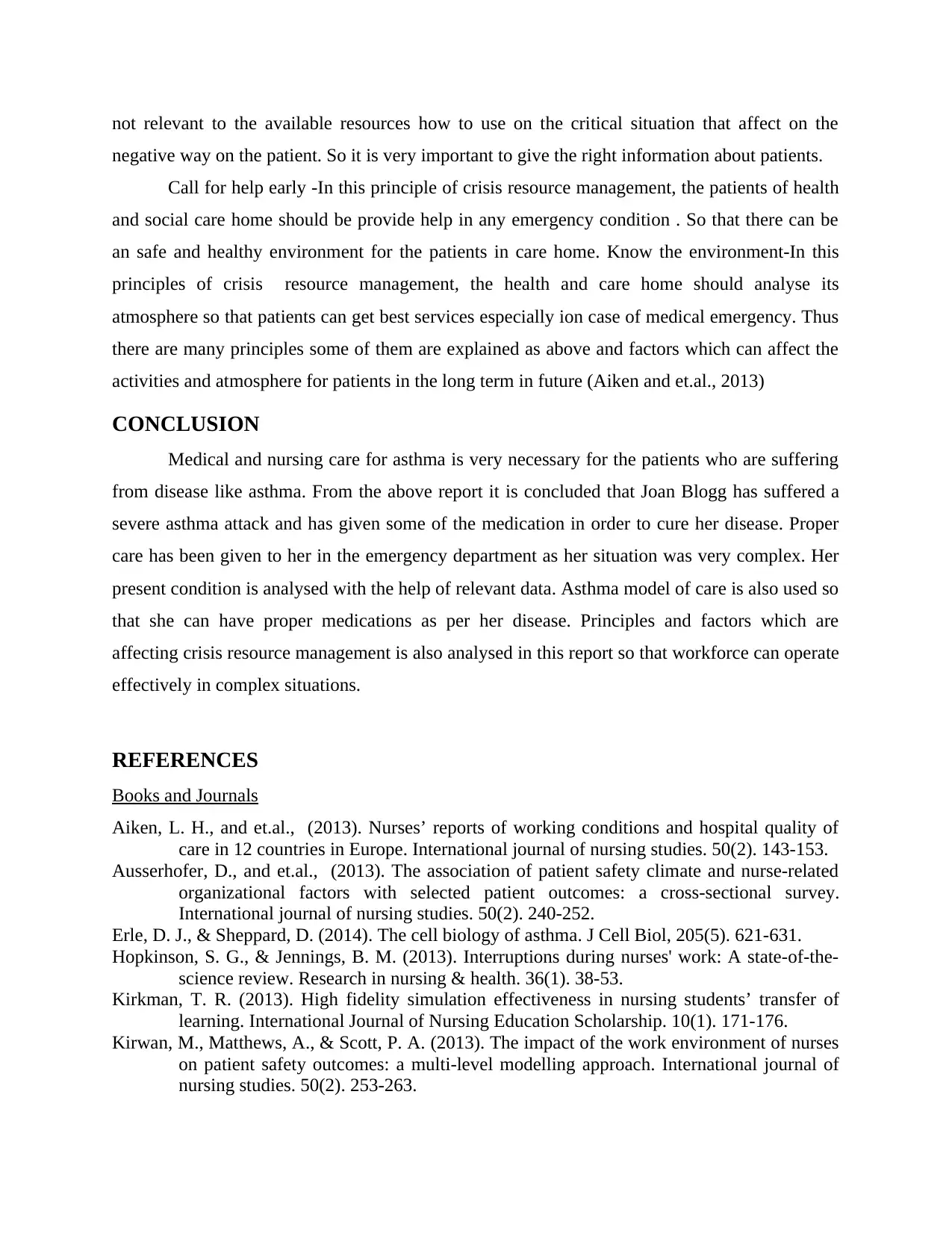
not relevant to the available resources how to use on the critical situation that affect on the
negative way on the patient. So it is very important to give the right information about patients.
Call for help early -In this principle of crisis resource management, the patients of health
and social care home should be provide help in any emergency condition . So that there can be
an safe and healthy environment for the patients in care home. Know the environment-In this
principles of crisis resource management, the health and care home should analyse its
atmosphere so that patients can get best services especially ion case of medical emergency. Thus
there are many principles some of them are explained as above and factors which can affect the
activities and atmosphere for patients in the long term in future (Aiken and et.al., 2013)
CONCLUSION
Medical and nursing care for asthma is very necessary for the patients who are suffering
from disease like asthma. From the above report it is concluded that Joan Blogg has suffered a
severe asthma attack and has given some of the medication in order to cure her disease. Proper
care has been given to her in the emergency department as her situation was very complex. Her
present condition is analysed with the help of relevant data. Asthma model of care is also used so
that she can have proper medications as per her disease. Principles and factors which are
affecting crisis resource management is also analysed in this report so that workforce can operate
effectively in complex situations.
REFERENCES
Books and Journals
Aiken, L. H., and et.al., (2013). Nurses’ reports of working conditions and hospital quality of
care in 12 countries in Europe. International journal of nursing studies. 50(2). 143-153.
Ausserhofer, D., and et.al., (2013). The association of patient safety climate and nurse-related
organizational factors with selected patient outcomes: a cross-sectional survey.
International journal of nursing studies. 50(2). 240-252.
Erle, D. J., & Sheppard, D. (2014). The cell biology of asthma. J Cell Biol, 205(5). 621-631.
Hopkinson, S. G., & Jennings, B. M. (2013). Interruptions during nurses' work: A state‐of‐the‐
science review. Research in nursing & health. 36(1). 38-53.
Kirkman, T. R. (2013). High fidelity simulation effectiveness in nursing students’ transfer of
learning. International Journal of Nursing Education Scholarship. 10(1). 171-176.
Kirwan, M., Matthews, A., & Scott, P. A. (2013). The impact of the work environment of nurses
on patient safety outcomes: a multi-level modelling approach. International journal of
nursing studies. 50(2). 253-263.
negative way on the patient. So it is very important to give the right information about patients.
Call for help early -In this principle of crisis resource management, the patients of health
and social care home should be provide help in any emergency condition . So that there can be
an safe and healthy environment for the patients in care home. Know the environment-In this
principles of crisis resource management, the health and care home should analyse its
atmosphere so that patients can get best services especially ion case of medical emergency. Thus
there are many principles some of them are explained as above and factors which can affect the
activities and atmosphere for patients in the long term in future (Aiken and et.al., 2013)
CONCLUSION
Medical and nursing care for asthma is very necessary for the patients who are suffering
from disease like asthma. From the above report it is concluded that Joan Blogg has suffered a
severe asthma attack and has given some of the medication in order to cure her disease. Proper
care has been given to her in the emergency department as her situation was very complex. Her
present condition is analysed with the help of relevant data. Asthma model of care is also used so
that she can have proper medications as per her disease. Principles and factors which are
affecting crisis resource management is also analysed in this report so that workforce can operate
effectively in complex situations.
REFERENCES
Books and Journals
Aiken, L. H., and et.al., (2013). Nurses’ reports of working conditions and hospital quality of
care in 12 countries in Europe. International journal of nursing studies. 50(2). 143-153.
Ausserhofer, D., and et.al., (2013). The association of patient safety climate and nurse-related
organizational factors with selected patient outcomes: a cross-sectional survey.
International journal of nursing studies. 50(2). 240-252.
Erle, D. J., & Sheppard, D. (2014). The cell biology of asthma. J Cell Biol, 205(5). 621-631.
Hopkinson, S. G., & Jennings, B. M. (2013). Interruptions during nurses' work: A state‐of‐the‐
science review. Research in nursing & health. 36(1). 38-53.
Kirkman, T. R. (2013). High fidelity simulation effectiveness in nursing students’ transfer of
learning. International Journal of Nursing Education Scholarship. 10(1). 171-176.
Kirwan, M., Matthews, A., & Scott, P. A. (2013). The impact of the work environment of nurses
on patient safety outcomes: a multi-level modelling approach. International journal of
nursing studies. 50(2). 253-263.
⊘ This is a preview!⊘
Do you want full access?
Subscribe today to unlock all pages.

Trusted by 1+ million students worldwide
1 out of 13
Related Documents
Your All-in-One AI-Powered Toolkit for Academic Success.
+13062052269
info@desklib.com
Available 24*7 on WhatsApp / Email
![[object Object]](/_next/static/media/star-bottom.7253800d.svg)
Unlock your academic potential
Copyright © 2020–2025 A2Z Services. All Rights Reserved. Developed and managed by ZUCOL.




